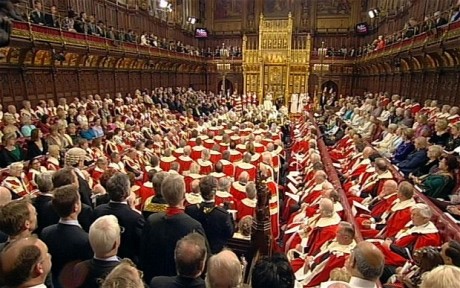When Wellington licked Bonaparte,
As every child can tell,
The House of Peers throughout the war
Did nothing in particular
And did it very well (Gilbert and Sullivan, Iolanthe, Act II, ‘Mountararat’s Song’)
In an election held this month, Raymond Benedict Bartholomew Michael Asquith, third earl of Oxford and Asquith was elected to take up the seat in the House of Lords vacated by the death of Robert Alexander Hold Methuen, the seventh baron Methuen. The ballot was conducted using AV (the Alternative Vote), but Lord Oxford received 155 votes of the 283 votes (55%), so preferences were not taken into account. (The proxime accessit, Lord Napier and Ettrick, received only 35 votes, and seven of the fifteen candidates received only one vote or none at all.) Turnout was 36%. All members of the House of Lords (currently 776) were eligible to vote. The new member will sit with the Liberal Democrat peers, as did his predecessor.
This unusual process is a result of a compromise reached when the House of Lords was reformed in 1998 and 1999. The Labour Party manifesto in 1997 had proposed to remove all of the hereditary peers from the house, but in a departure from the Salisbury-Addison convention the Lords objected and prevailed, forcing the government to retain 92 of them. (McLean 2009: 234) (In reality, only ninety were retained. The other two hereditaries are held ex officio by great officers of state: the Earl Marshal and the Lord Great Chamberlain, who are peers.) Lord Cranborne, who as Conservative leader of the Lords engineered this bargain, failed to tell his leader William Hague about it and was sacked when Hague learned of it independently.
Of the candidates this month, two were Liberal Democrats, nine were Conservatives and four were nominal cross-benchers. It has been pointed out that Viscount Massereene, who ran as a cross-bencher, was a member of the Monday Club. All were men, and the average age was approximately 64. Votes in support of the parties were substantially different: 184 votes were cast in support of the two Liberal Democrats; 48 in support of the cross-benchers; and 51 in support of the Conservatives. It is easy to find entertaining information about the candidates. Lord Sudeley (who received one vote) is a member of the International Monarchist League, whose ‘purpose is, quite simply, to support the principle of Monarchy’. Lord Rowallan (who received no votes) was admonished for striking his former wife at an equestrian event and commented respecting his divorce settlement: ‘It is unfortunate that wives, whether they are chucked out or leave of their own accord, do very nicely under the British legal system.’ Even if the election system filters candidates, the hereditary principle and the nomination process for these positions do not.
All of this would be amusing, were it not part of a larger problem. The House of Lords also includes twenty-six Lords Spiritual, five of whom (the Archbishops of Canterbury and York and the Bishops of Durham, Lincoln and Winchester) sit ex officio and twenty-one of whom are senior bishops in the Church of England: making laws for the entire UK despite the fact that the Church of England is the established church in only one of the four nations of the UK. The remaining 658 members are life peers. Beginning with the Labour governments of Tony Blair, which introduced 374 new peers into the house in order to balance the Conservative majority that had developed under the previous Conservative governments, the size of the house has grown substantially. (Russell et al. 2011: 6) Meg Russell and her collaborators believe that this increase has ‘caused problems for the effective operation of the chamber,’ including its rising cost; a lack of time for interested members to participate in its deliberations; and a lack of socialization of new members, leading to increased fractiousness and partisanship. Even so, three and one-half years into its five-year term, the Conservative-Liberal Democrat coalition government had appointed 160 peers, 43% of the number appointed during the ten-year duration of the previous Labour governments. Nor is the house as inactive as it was in the days of Wellington and Bonaparte: in the last session the government was defeated fourteen times; in the session before, twenty-six times; and in the session before that, 48 times. An active but dysfunctional house of the legislature can lead to serious problems.
The problem with changing any of this is institutional resistance. One of the government defeats was on a bill recommending that the government restrain itself from appointing more peers. And in 2012 90 backbench MPs voting against their government’s three-line whip on the programme motion for the House of Lords Reform Bill 2012. The bill would have made the house predominantly an elected one by 2025, although limited numbers of bishops and life peers would have remained. The Conservative rebels, joined by Labour MPs, forced the government to abandon the bill even though it had been part of the coalition agreement. Liberal Democrat leader Nick Clegg accused the Conservatives of breaking the coalition contract. In retaliation, he withdrew Liberal Democrat support for changes to constituency boundaries for the 2015 election, which virtually eliminates the potential for a Conservative majority.
However, in the wake of the Scottish independence referendum, it is possible that we are entering into a constitutional moment. (Ackerman 2000) One function of upper houses is to hold diverse nations together. No one proposes that the inequality of the US Senate, which privileges states with small populations like Wyoming and Vermont, be imposed on the UK. But in the process of deciding what powers should be allocated to devolved governments in the UK it may be necessary to revisit the anachronism of the House of Lords and to arrive at an acceptable solution to its incongruous position in a modern democracy.









No Comment